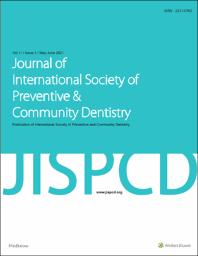Mostrar el registro sencillo del ítem
Original Article Cleaning of Endodontic Files with and without Enzymatic Detergent by Means of the Manual Method Versus the Ultrasonic Method: An Experimental Study
| dc.contributor.author | Cayo-Rojas1, César Félix2,3,4 | |
| dc.contributor.author | Brito-Ávila5, Estefany | |
| dc.contributor.author | Aliaga-Mariñas2, Ana S | |
| dc.contributor.author | Hernández-Caba2, Karen K. | |
| dc.contributor.author | Saenz-Cazorla3, Emylain D.5 | |
| dc.contributor.author | Ladera-Castañeda1, Marysela I.2 | |
| dc.contributor.author | Cervantes-Ganoza3, Luis A. | |
| dc.date.accessioned | 2021-06-17T04:15:12Z | |
| dc.date.available | 2021-06-17T04:15:12Z | |
| dc.date.issued | 2021 | |
| dc.identifier.uri | https://hdl.handle.net/20.500.14308/3071 | |
| dc.description.abstract | The aim of this article is to evaluate the cleanliness level achieved with and without the application of enzymatic detergent for the manual method versus the ultrasonic method, applied to Flexoreamer K-type files No. 25, No. 30, and No. 35. Materials and Methods: 192 K-type Flexoreamer files were divided into four categories: A1 (ultrasonic method with enzymatic detergent), A2 (ultrasonic method without enzymatic detergent), B1 (manual method with enzymatic detergent), and B2 (manual method without enzymatic detergent). Each category was randomly distributed in three groups of 16 files each (No. 25, No. 30, and No. 35). The files were used for biomechanical instrumentation of the root canal in premolars. The active part of the files was examined under a stereomicroscope, considering four cleaning levels: 4 (100% cleanliness), 3 (95– 99% cleanliness), 2 (85–94% cleanliness), 1 (75–84% cleanliness), and 0 (less than 75% cleanliness). For hypothesis testing, the Mann–Whitney U-test was used to differentiate between techniques, and the Kruskal–Wallis multiple comparison test was used to compare pairs of files within each cleaning method. Results: When using enzymatic detergents, the manual and ultrasonic methods did not show significant differences when comparing each group of the files analyzed (P > 0.05). However, when comparing the cleaning level without enzymatic detergent between the manual and ultrasonic methods, we observed that it obtained a superior result when compared with the manual method for each type of file: No. 25 (P = 0.021), No. 30 (P < 0.001), and No. 35 (P < 0.001). Both methods achieved a significantly higher level of cleaning with the application of the enzymatic detergent (P < 0.05) than without applying it. Conclusion: The ultrasonic cleaning method proved to be the most effective method for the removal of biologic waste when compared with the manual method using a nylon brush. However, there was no significant difference between these two methods when enzymatic detergent was used | es_PE |
| dc.format | application/pdf | es_PE |
| dc.language.iso | eng | es_PE |
| dc.publisher | Journal of International Society of Preventive and Community Dentistry | es_PE |
| dc.rights | info:eu-repo/semantics/openAccess | es_PE |
| dc.rights | Attribution-NonCommercial-NoDerivs 3.0 United States | * |
| dc.rights.uri | licenses/by-nc-nd/3.0/us/ | es_PE |
| dc.rights.uri | http://creativecommons.org/licenses/by-nc-nd/3.0/us/ | * |
| dc.source | Universidad Privada San Juan Bautista | es_PE |
| dc.source | Repositorio Institucional UPSJB | es_PE |
| dc.subject | Biologic waste | es_PE |
| dc.subject | endodontic files | es_PE |
| dc.subject | enzymatic detergent, | es_PE |
| dc.subject | nylon brush | es_PE |
| dc.subject | ultrasonic waves | es_PE |
| dc.title | Original Article Cleaning of Endodontic Files with and without Enzymatic Detergent by Means of the Manual Method Versus the Ultrasonic Method: An Experimental Study | es_PE |
| dc.type | info:eu-repo/semantics/article | es_PE |
| dc.publisher.country | PE |


